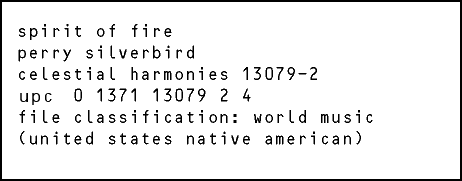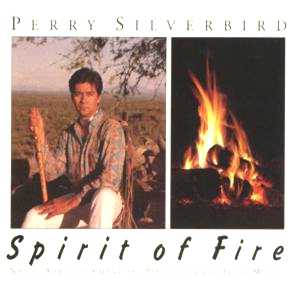 |
|||||||||||||||||||||||||||||||||||||||||||||||||||||||||
 
Die amerikanischen Ureinwohner wanderten vor etwa 10.000 Jahren über die Behringstrasse aus Zentralasien ein und verteilten sich dann über Nord-, Mittel- und Südamerika. Alle indianischen Völker bewahrten ihr schamanisches Erbe und entwickelten es je nach Klima und Landschaft. Trotz der europäischen Invasion und der Überlagerung durch andere Kulturen und Religionen sind viele der ursprünglichen Rituale mit der dazu gespielten Musik noch heute lebendig oder werden von engagierten indianischen Musikern zu neuem Leben erweckt. Es gibt in Amerika neben der „schwarzen“eine „rote“ Musik, die mit der Natur dieses Kontinents tief verbunden ist. Der Navajo-Appache trat mit sieben Jahren das Erbe seiner musikalischen Familie an. Zunächst faszinierte ihn die Trommel, danach suchte sein eher stilles Temperament nach einer größeren Bandbreite des Gefühlsausdrucks. Die Flöte wurde sein Hauptinstrument. Sein Vater und Lehrer, Reuben Silverbird, gab ihm den Namen „Gentle Flute Poet“. Er selbst nennt seine Musik „Free Spirit Music“und versteht sich dabei als Instrument der göttlichen Natur. Da die Silverbird-Familie stets auf Reisen war, nahm Perry schon früh die unterschiedlichsten kulturellen Einflüsse in sich auf, lernte Musiker wie Steven Roach und damit die komplexe Welt des Tonstudios kennen. Kaum ein indianischer Musiker bringt seine Tradition so einfühlsam und meditativ mit elektronischen Klängen zusammen wie Perry Silverbird. Die 18 Stücke für indianische Flöte, rituellen Gesang und Trommel sind dem Geist des Feuers und Perrys Frau Shanajé gewidmet. Produzent Steve Roach steuerte die Naturaufnahmen bei. Hier wirkt alles echt, einfach, natürlich und berührend. Feuer bedeutet in der indianischen Tradition Reinheit, Kreativität und Unsterblichkeit. Wir können diese Qualitäten in Perrys Musik spüren. Klar und einfach sind die Linien seiner Flötenmelodien, visionär und inspirierend seine Gesänge, die bei ihm in einer Art Trance aus der Tiefe des Herzens kommen, und wie die Zyklen des Lebens entführt die gleichmäßig schlagende Trommel in einen Rhythmus jenseits der linearen Zeit. the projectFire is the inspiration for this release of the young
Navajo/Apache artist, Perry Silverbird. To Native Americans, fire
represents purity, creativity, and immortality; all of which are attributes
of Silverbird's music. Purity is apparent in the serenely soulful
notes of the flute that weave a tapestry of clarity and brilliance.
The spirituality of his performance is awing which is not surprising
considering that Silverbird strongly believes that the message of
God is manifested through his music.
The creativity of the artist can be seen in his imaginative, mystical chanting that can be dreamy, peaceful, and powerful at the same time. Encouraged by producer Steve Roach, this release includes much more chanting than Silverbird's previous work, and it can take a toll on the artist. Silverbird asserts that chanting does not come easily to him. The musician must get into an almost trance–like state in order to be able to express the essence of one's being and spirit through chants. Silverbird claims that a fire inside him kindles the need to express himself and chanting is surely an eloquent and powerful means of doing so. Finally, the constant, pulsing beat of the drums illustrates the immortality of man's spirit as he and his descendants continue to perform these ancient rhythms. The messages expressed in each song are also immortal in their significance to people everywhere. Silverbird states that each song conveys a situation or emotion that most people have experienced. For example, one of the most poignant songs, Tsegihi (Prayer of the Night Flute), paints an aural picture of how we are when alone. Fed by the flames of creativity and fueled by sparks of inspiration, the Spirit of Fire is a sizzling union of flute–playing, percussion, and chanting that is both primal and contemporary. the artistA fourth generation performer, Perry Silverbird has
been a musician since the age of seven. His first passion was the
drums because of the power he was able to express while performing;
however, he soon needed an outlet to convey his gentle nature. He
found that with the flute, he was able to express a wider range of
emotions, hence his name, Gentle Flute Poet.
Because he and his family were always on the road, Silverbird was able to meet people from different cultures and backgrounds. These experiences found their way into his music, creating a sound that appeals to a broad range of people. His Native American heritage has also been a driving force in his music and his strong tie with this legacy, as well as with nature, can be clearly seen throughout his works. discographytracklist
|
|||||||||||||||||||||||||||||||||||||||||||||||||||||||||
|
|
|||||||||||||||||||||||||||||||||||||||||||||||||||||||||
 |


